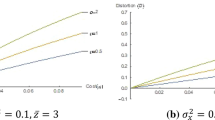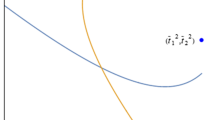Conclusions
The interpretation of the long-standing fiscal illusion hypothesis presented here is that the illusion is the result of attempts by utility maximizing public managers (politicians or bureaucrats) to direct the resources of the community toward themselves. In general, they will succeed if the costs of information about or enforcement of managerial behavior are nonzero, and political competition is imperfect. The consequences of this application of the Williamson theory of the firm, in the context of a median voter model, include the following:
-
1.
There will be an optimal level of illusion for the public manager and median voter simultaneously; and this is consistent with the rationality of all agents.
-
2.
Underestimation of tax-prices by the median voter at this point by itself does not imply a continually growing public sector.
-
3.
Misperception of taxes or expenditures alone does not imply anything about the affect of misperception on the size of the budget. For the same reason, a change in information costs is ambiguous (in the present model) in its effects on budget size, because this will influence both tax and expenditure illusions.
-
4.
The importance of tax or expenditure structure manipulation in determining the size of the budget is an empirical question. It may be that the fiscal illusion hypothesis is empirically relevant, or it may not. Whether illusion collapses over time depends on such factors as the age structure of the electorate and the extent of political competition.
It is interesting to note, incidentally, that the real ‘hidden persuaders’ may well be in the public sector if competition is more imperfect in political markets than in private. Yet, those who complain about the artificial creation of wants by private business call at the same time for greater government intervention.
Similar content being viewed by others
References
Alchian, A.A. (1965). The Basis of Some Recent Advances in the Theory of Management of the Firm. Journal of Industrial Economics (Nov.).
Backhaus, J. (1968). Pareto on Public Choice. Public Choice, 33.
Bartlett, R. (1973). Economic Foundations of Political Power. Collier McMillan Publishers. 1973.
Black, D. (1958). The Theory of Committees and Elections. Cambridge University Press.
Borcherding, T.E. (1977). (Ed.) Budgets and Bureaucrats. Duke University Press.
Breton, A. (1974). The Economic Theory of Representative Government. Aldine.
Browning, E.K. (1975). Why the Social Insurance Budget is Too Large in a Democracy. Economic Inquiry, 13.
Buchanan, J. (1967). Public Finance in Democratic Process. University of North Carolina Press.
Buchanan, J., and Wagner, R. (1977). Democracy in Deficit. Academic Press.
Buchanan, J., and Wagner, R. (1978). Dialogues Concerning Fiscal Religion. Journal of Monetary Economics, 4.
Clotfelter, C. (1976). Public Spending for Higher Education: An Empirical Test of Two Hypotheses. Public Finance, 31.
Darby, M., and Karni, E. (1973). Free Competition and the Optimal Amount of Fraud. Journal of Law and Economics, 16.
Downs, A. (1957). An Economic Theory of Democracy. Harper & Row.
Downs, A. (1960). Why the Government Budget is Too Small. World Politics, July.
Johnson, H.F. (1977). A Note on the Dishonest Government and the Inflation Tax. Journal of Monetary Economics, 3.
McCulloch, J.R. (1851). The Funding System.
McManus, J. (1975). The Costs of Alternative Economic Organizations. Canadian Journal of Economics, 8 (August).
Migue, J., and Belanger, G. (1974). Toward a General Theory of Marginal Discretion. Public Choice, 17.
Mill, J.S. (1848). Principles of Political Economy. Ashley Edition, Kelly, 1976.
Niskanen, W.A. (1975). Bureaucrats and Politicians. Journal of Law and Economics, 18 (December).
Orzechowski, W. (1977). Economic Models of Bureaucracy: Survey, Extensions and Evidence. In T.E. Borcherding (Ed.), Budgets and Bureaucrats. Duke University Press.
Pommerehne, W.W., and Schneider, F. (1978). Fiscal Illusion, Political Institutions and Local Public Spending: Some Neglected Relationships. Kyklos, 31.
Puviani, A. (1903). Teoria Della Illusione Finanziaria. Remo Sandron, Milan.
Ricardo, D. (1817). Principles of Political Economy and Taxation. Penguin, 1971.
Shefrin, H. (1978). Differential Information and Informational Equilibrium. Economic Letters, 1.
Staaf, R.J. (1978). Homo Politicus and Homo Economicus: Advertising and Information. In D. Tuerck (Ed.), The Political Economy of Advertising. Washington, D.C., American Enterprise Institute.
Stigler, G. (1961). The Economics of Information. Journal of Political Economy, 69.
Stigler, G. (1972). Economic Competition and Political Competition. Public Choice.
Tullock, G. (1967). Towards a Mathematics of Politics. University of Michigan Press.
Wagner, R. (1974) Revenue Structure, Fiscal Illusion and Budgetary Choice. Public Choice.
Walters, A.A. (1971). Consistent Expectations, Distributed Lags and the Quantity Theory. Economic Journal, 81.
Williamson, O.E. (1964). The Economics of Discretionary Behavior: Managerial Objectives in the Theory of the Firm. Prentiss Hall.
Williamson, O.E. (1967). Hierarchical Control and Optimum Firm Size. Journal of Political Economy, 75.
Author information
Authors and Affiliations
Additional information
W.I.G. Gillespie, Walter Hettich, Allan Maslove, Werner Pommerehne and Daniel Rubinfeld commented most helpfully on earlier drafts of our paper. The usual caveat applied however.
Rights and permissions
About this article
Cite this article
West, E.G., Winer, S.L. Optimal fiscal illusion and the size of government. Public Choice 35, 607–622 (1980). https://doi.org/10.1007/BF00140089
Issue Date:
DOI: https://doi.org/10.1007/BF00140089




